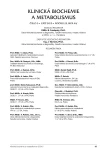-
Medical journals
- Career
Presepsin as a diagnostic and prognostic tool for sepsis
Authors: M. Beňovská 1,2; D. Bučková 1; D. Petříková 2; J. Stašek 3; J. Gottwaldová 1,2
Authors‘ workplace: Oddělení klinické biochemie, FN Brno 1; Katedra laboratorních metod, Lékařská fakulta, MU Brno 2; Klinika anesteziologie, resuscitace a intenzivní medicíny, FN Brno a LF MU Brno 3
Published in: Klin. Biochem. Metab., 23 (44), 2015, No. 3, p. 89-94
Overview
Objective:
To compare the results of presepsin determination with the results of the routinely used method of procalcitonin (PCT) determination on patients with sepsis. We use individual casuistries to describe the diagnostic significance of presepsin compared with PCT and their identical and different properties.Material and Methods:
From the original cohort of patients treated for sepsis in University Hospital Brno, 31 individuals with long-term monitoring of procalcitonin and CRP sepsis markers were selected, and measured simultaneously for presepsin. The patients were further divided into two groups - 23 survivors and 8 non-survivors. Four casuistries are described in detail.Analysis of presepsin was carried out using chemiluminescent enzyme immunoassay on the fully automated POCT instrument PATHFAST from Mitsubishi Chemical.Results:
The concentration of presepsin and PCT was compared between survivors and non-survivors. The evaluation of the results was based on samples from the first day after admission or development of sepsis, the day when the parameters reached the maximum value, and the date when monitoring of the septic condition was terminated (termination of hospitalization, exitus). A statistically significant difference between both groups was found at admission and at the end of sepsis monitoring for both presepsin (P=0.023 resp. P=0.002) and PCT (P=0.021 resp. P=0.0003). The given casuistries demonstrate that presepsin stays high in cases with a bad prognosis when compared to PCT.Conclusions:
Like PCT, presepsin is a suitable marker for diagnosis, monitoring and prognosis of sepsis. Our results and findings in the latest literature even indicate that presepsin is superior to procalcitonin as a prognostic marker of sepsis.Keywords:
presepsin, procalcitonin, sepsis, bacterial infection.
Sources
1. Masson, S., Caironi, P., Spanuth, E., Thomae, R., Panigada, M., Sangiorgi, G., et al. Presepsin (soluble CD14 subtype) and procalcitonin levels for mortality prediction in sepsis: data from the Albumin Italian Outcome Sepsis trial. Crit. Care 2014, 18, R6.
2. Faix, J. D. Presepsin – The new kid on the sepsis block. Clin. Biochem., 2014, 47, p. 503-504.
3. Endo, S., Suzuki, Y., Takahashi, G., Shozushima, T., Ishikura, H., Murai, A., et al. Presepsin as a powerful monitoring tool for the prognosis and treatment of sepsis: a multicenter prospective study. J. Infect. Chemo-ther., 2014, 20, p.30-34.
4. Zou, Q., Wen, W., Zhang, X. C. Presepsin as a novel sepsis biomarker. World J. Emerg. Med., 2014,5, p.16-9.
5. Damien. P., Cognasse. F., Eyraud. M. A., Arthaud. C. A., Pozzetto. B., Garraud. O., Hamzeh-Cognasse. H. LPS stimulation of purified human platelets is partly dependent on plasma soluble CD14 to secrete their main secreted product, soluble-CD40-Ligand. BMC Immunol., 2015,16, doi:10.1186/s12865-015-0067-2.
6. Endo, S., Suzuki, Y., Takahashi, G., Shozushima, T., Ishikura, H., Murai, A., et al. Usefulness of presepsin in the diagnosis of sepsis in a multicenter prospective study. J. Infect. Chemother., 2012,18, p.891-897.
7. Kweon, O. J., Choi, J. H., Park, S. K., Park, A. J. Usefulness of presepsin (sCD14 subtype) measurements as a new marker for the diagnosis and prediction of disease severity of sepsis in the Korean population. J. Crit. Care, 2014,14, p.245-247.
8. Agilli, M., Sener, I., Yesildal, F., Honca, T., Aydin, I., Akgul, E., et al. A new marker for the diagnosis of sepsis: Presepsin. J. Investig. Biochem., 2012,1, p.55-57.
9. Romualdo, L. G., Torrella, P. E., González, M. V., Sánchez, R. J., Holgado, A. H., Freire, A. O., et al. Diagnostic accuracy of presepsin (soluble CD14 subtype) for prediction of bacteremia in patients with systemic inflammatory response syndrome in the Emergency Department. Clin. Biochem., 2014,47, p.505-508.
10. Liu, B., Yin, Q., Chen, Y. X., Zhao, Y. Z., Li, C. S. Role of Presepsin (sCD14-ST) and the CURB65 scoring system in predicting severity and outcome of community-acquired pneumonia in an emergency department. Respir. Med., 2014,108, p.1204-1213.
11. Schneider, H. G., Lam, Q. T. Procalcitonin for the clinical laboratory: a review. Pathology. 2007,39, p.383-390.
12. Ciriello, V., Gudipati, S., Stavrou, P., Kanakaris, N., Bellamy, M., Giannoudis, P. Biomarkers predicting sepsis in polytrauma patiens: Current evidence. Injury, Int. Care Injured, 2013, 44, p. 1680-1692.
13. Novelli, G., Morabito, V., Ferretti, G., Pugliese, F., Ruberto, F., Venuta, F., et al. Pathfast Presepsin assay for early diagnosis of bacterial infections in surgical patiens: preliminary study. Transplant. Proc. 2013, 45, p. 2750-2753.
Labels
Clinical biochemistry Nuclear medicine Nutritive therapist
Article was published inClinical Biochemistry and Metabolism

2015 Issue 3-
All articles in this issue
- Presepsin as a diagnostic and prognostic tool for sepsis
- The use of soluble cytokeratin fragments in the diagnosis of liver metastases.
- Monitoring of DNA methylation in ovarian cancer using microarrays.
-
Bias měření základních analytů krevního séra.
Výsledky a interpretace soudobých studií. - The permissible limits for intermediate precision in control charts
- Appreciation
- Program of lecture blocks
- List of posters
- Abstract of lectures
- Abstract of posters
- Index of the authors of abstracts
- Clinical Biochemistry and Metabolism
- Journal archive
- Current issue
- Online only
- About the journal
Most read in this issue- Presepsin as a diagnostic and prognostic tool for sepsis
-
Bias měření základních analytů krevního séra.
Výsledky a interpretace soudobých studií. - Abstract of posters
- The permissible limits for intermediate precision in control charts
Login#ADS_BOTTOM_SCRIPTS#Forgotten passwordEnter the email address that you registered with. We will send you instructions on how to set a new password.
- Career

